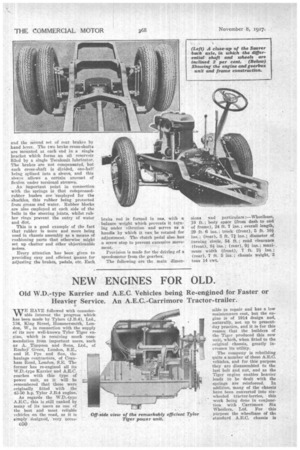NEW ENGINES FOR OLD.
Page 108

Page 109

If you've noticed an error in this article please click here to report it so we can fix it.
As regards the W.D.-type: C, this is still ranked by many of its users as one of the best and most reliable vehicles on the road, as it is simply designed, very acces sible to repair and has a low maintenance cost, but the engine is of 1914 design and, .naturally, not up to presentday practice, and it is for this reason that the builders of the Tiger produced this new unit, which, when fitted to the original chassis, greatly increases its utility.
The company is rebuilding quite a number of these A.E.C. vehicles, and for this purpose they are disassembled to the last bolt and nut, and as the Tiger engine enables heavier loads to be dealt with the springs are reinforced. In addition, many of the chassis have been converted into six-wheeled tractor-lorries, this work being done in conjunction with Carrimore Six Wheelers, Ltd. For this purpose the wheelbase of the. standard A.E.C. chassis is
reduced to 12 ft. 2 ins., and the Carrimore attachment fitted; modified in this manner, the complete vehicles can easily deal with loads up to 12 tons.
As regards the maintenance of these vehicles, there are so many km the road . in use by transport concerns and railway companies that spare parts are readily available.
The Tyler Tiger engine was deseribed in detail in The Commircial Meter, dated November 16th, 1926, and it is, therefore, unnecessary for us to give full
details of it now. .
Briefly, it has cylinders of 5-in. bore sad 6-in. stroke, cast in pairs with aistotis of aluminium alloy or east-iron, as required. Case-hardened steel is used for the gudgeon pins, which float in the Pistons and are secured in the connect ing rods.
The crankcase is built up of three aluminium castings, the top half carrying all the bearings, the oil pump, • tappet guides, etc. .Heat-treated nick.el-steel forgings with ground journals are used for the dynamically balanced cranksinaft. It has an effective oil thrower and oil-return thread at. the rear end.
The timing gear is driven by a very large Renold silent chain, adjustable from the exterior of the crankcase.
Lubrication is by splash to the cylinders and big-ends and by pressure. to the
mail/ bearings and front camshaft bearing. A dual-type oil pump is employed, this giving a separate flow to the splash and pressure systems.
As compared with the original 3-.B.4, the new engine has much larger bearing surfaces, also the rear main beariings are interchangeable with the front, whilst the centre main bearing is the same Size as the big-ends, thus facilitating the provision of replacement parts.
The top water connection is made in halves so that one pair of cylinders can ho moved without disturbing the other. There is, no fear now of cracking occurring at the bridges between the valvecap orifices, as used to happen.




















































































































































































